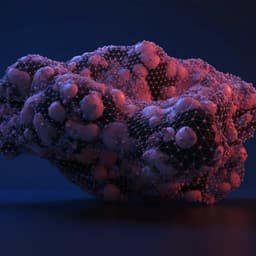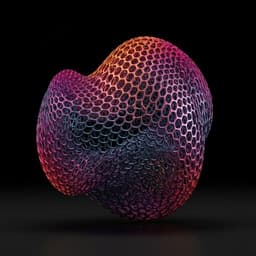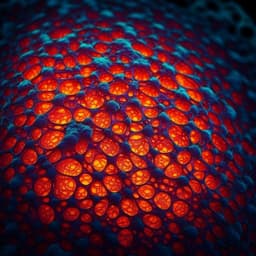
Engineering and Technology
Machine learning assisted design of shape-programmable 3D kirigami metamaterials
N. A. Alderete, N. Pathak, et al.
This innovative research by Nicolas A. Alderete, Nibir Pathak, and Horacio D. Espinosa presents a cutting-edge machine learning framework tailored for designing and controlling kirigami-based materials. By utilizing clustering, tandem neural networks, and symbolic regression, the framework predicts optimal kirigami cut layouts to meet specific design criteria, showcasing its effectiveness in developing shape-shifting metamaterials.
~3 min • Beginner • English
Introduction
The study addresses the inverse-design problem for kirigami metamaterials: determining cut layouts that produce desired, programmable 3D out-of-plane deformations under stretch. While kirigami offers rich shape-morphing behavior via bifurcations of cut sheets, rational design is difficult due to strong nonlinearities, vast design spaces, and lack of analytical models. Prior work often relied on trial-and-error or optimization that is computationally intensive, and ML studies have focused mainly on mechanical properties rather than topological reconfigurability with experimental validation. The purpose here is to provide a comprehensive, data-driven framework that (1) explores the design space, (2) performs inverse design to map target deformations to cut geometries, (3) predicts deployment conditions and tunability, and (4) extends to configurations outside the initial design space, validated experimentally from the meta-atom to metamaterial level.
Literature Review
Previous investigations mapped only subsets of kirigami geometries within a common motif, revealing diverse symmetric and antisymmetric shapes but lacking comprehensive coverage. Inverse design approaches have primarily used optimization, effective but expensive for buckling-dominated, nonlinear responses where each new target requires extensive re-search. Data-driven methods in mechanical metamaterials have shown promise for navigating large design spaces, but most ML work on kirigami has targeted strength/strain metrics rather than programmable 3D shape reconfigurability and path-dependent deployment. This work addresses these gaps by focusing on deformation-shape programmability with end-to-end ML and experimental validation.
Methodology
A specific kirigami meta-atom motif (two inner panels bounded by internal line cuts and U-shaped cuts) is parameterized by sheet dimensions (L, W, t), hinge lengths (a1–a4), cut dimensions (h, w, c), edge offsets (d), material properties (E, ν), and uniaxial stretch (σ). The geometric design space is sampled using a space-filling Sobol sequence. For each geometry, linear buckling finite element analysis (FEM) provides imperfection modes to trigger bifurcations, and geometrically nonlinear FEM computes post-buckling deformations and force–displacement responses. Deformation descriptors are extracted as the deformed coordinates of the centerline across the inner panels and the two lateral edges per panel, sufficient to capture panel tilts (θ1–θ2) and twists (ψ). Force–displacement curves are also recorded. The framework has three ML components: (1) Design-space exploration via fitting the centerline deformation with a 5-knot B-spline to obtain five coefficients, dimensionality reduction to two principal components via SVD (>98% variance retained), and k-means clustering to partition the deformation space into representative shape clusters. (2) Inverse design using a tandem deep neural network (T-DNN) that maps target deformed configurations (e.g., desired θ1, θ2, ψ and/or deformation coordinates) to kirigami cut parameters (e.g., hinge lengths a1–a4 and other geometric variables), trained on the FEM-generated dataset. (3) Symbolic regression (SR) to derive surrogate relations for control and tunability, predicting variables such as required force levels and deformation sensitivity (e.g., angular change per applied force squared) for the designed motifs. Experimental validation is performed on selected inverse-designed cases to compare predicted versus observed deformations and structural responses. The framework is then applied at the metamaterial level by arranging designed meta-atoms into 1D/2D arrays for bioinspired functionalities. Additionally, heuristic adjustments guided by ML outputs (e.g., tuning hinge lengths and U-cut widths) are used to achieve configurations outside the initially sampled design space without retraining.
Key Findings
- The deformation space of the studied kirigami motif, sampled over ten geometric parameters, can be compactly represented by two principal components capturing over 98% of variance of the 5-coefficient B-spline descriptor of the centerline shape.
- k-means clustering partitions the deformation space into five well-defined clusters, largely comprising symmetric and asymmetric linear shapes and nonlinear shapes (e.g., V- and other curved profiles with mirror images), providing a map of achievable out-of-plane configurations.
- Inverse design with the T-DNN yields specific cut layouts that achieve target deformations, validated experimentally in three representative cases: (I) linear kirigami without twist; (II) linear kirigami with twist; (III) nonlinear kirigami. Example predicted hinge-length sets (a1–a4) produce target tilts and twists close to design values, and FEM-predicted force–displacement responses agree in trend with experiments.
- Symbolic regression provides surrogate control relationships, yielding predicted force levels and deformation sensitivities for designed motifs. Reported examples indicate approximate forces at target deformations of F ≈ 0.11 N (Cases I–II) and F ≈ 0.17 N (Case III), with corresponding angular sensitivity coefficients k on the order of 5.10^4, 1.10^3, and 4.10^-3 °/N^2, respectively.
- Discrepancies between predictions and experiments are attributed to neglected higher-order imperfection modes, material plasticity in hinge regions, and manufacturing-induced imperfections (e.g., local charring, geometric deviations, residual stresses).
- At the metamaterial level, four bioinspired designs demonstrate applicability: (a) a metatexture with symmetric tilts (θ1–2 ≤ ~12°) for particle entrapment; (b) an angled triangular arrangement for droplet transport; (c) a solar-tracking metatexture achieving extreme tilts (≥45°) by ML-assisted heuristic tuning beyond the initial design space; and (d) a parabolic-reflector-like kirigami dome with tunable foci via adjusted vertical and inner cut dimensions.
- The framework enables extension beyond the initial training space without retraining by using ML outputs as starting points and applying targeted geometric tuning, suggesting paths to automation via adaptive learning.
Discussion
The integrated framework addresses the kirigami inverse-design challenge by first charting the feasible deformation landscape and then providing a direct mapping from target shapes to cut geometries, along with surrogate control laws for deployment and tunability. Clustering supplies an interpretable atlas of achievable shapes, informing design targets and constraints. The T-DNN enables rapid inverse design of cut layouts that realize prescribed tilts and twists, reducing reliance on computationally expensive optimization or trial-and-error. Symbolic regression models contribute actionable predictions for actuation requirements (e.g., forces) and sensitivity, facilitating practical control strategies. Experimental validations confirm that the designed motifs produce the intended deformations and force responses, while observed deviations highlight the importance of including additional physical effects (imperfection interactions, plasticity, manufacturing variations) for high-fidelity prediction. Applications to bioinspired metasurfaces demonstrate that the approach scales from meta-atom to metamaterial, and that ML-guided heuristic adjustments can achieve configurations outside the initial design space, underscoring the framework’s versatility for real-world deployment.
Conclusion
The work introduces and experimentally validates a comprehensive, data-driven framework for the inverse design and control of shape-programmable kirigami metamaterials. By combining clustering-based exploration, a tandem DNN for inverse mapping, and symbolic-regression surrogates for tunability, the approach accelerates rational design from meta-atom to metamaterial architectures. Demonstrations include multiple deformation clusters, successful inverse-designed meta-atoms (linear, twisted, nonlinear), and bioinspired metasurfaces (particle capture, droplet transport, solar tracking with extreme tilts, and parabolic reflectors). Future research directions include expanding to broader and more complex cut patterns, leveraging CNNs on motif images, supervised autoencoders and variational autoencoders for inverse mapping, and employing active transfer learning and data augmentation to reach beyond initial training spaces. Incorporating material properties, initial imperfections, distributed actuation, and uncertainty quantification (e.g., probabilistic/Bayesian ML) will further enhance reliability and generalizability.
Limitations
The current study explores a relatively limited region of the geometric design space and focuses on a specific kirigami motif. FEM-based datasets do not fully capture higher-order imperfection modes and their interactions, potential plasticity in hinge regions, or manufacturing-induced imperfections (local charring, geometric deviations, residual stresses), leading to discrepancies with experiments. The initial training space constrained achievable tilts (≈20°), necessitating heuristic tuning to reach extreme tilts (≥45°). Broader applicability will require expanded datasets, inclusion of additional physics, and uncertainty-aware modeling.
Related Publications
Explore these studies to deepen your understanding of the subject.







